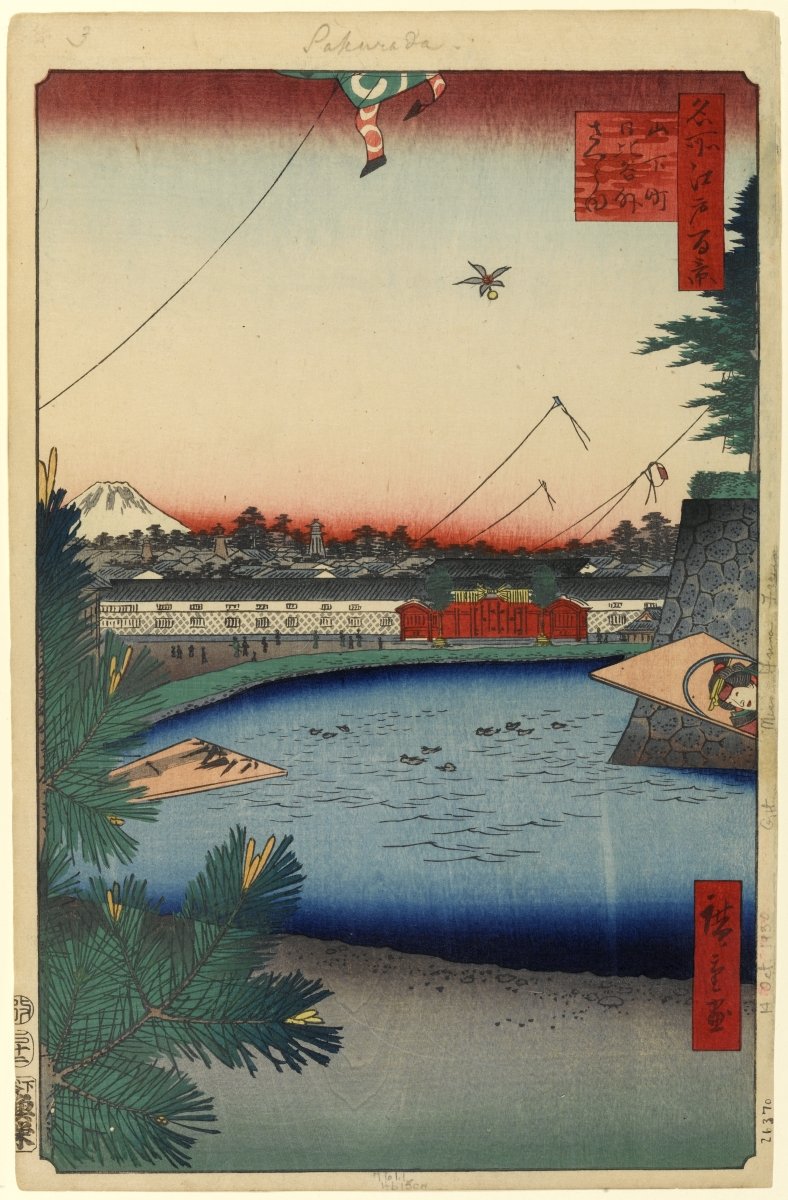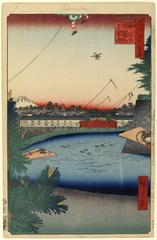
Hibiya Park Tokyo: Visiting Hours, Tickets, and Comprehensive Guide to Historical Sites
Date: 14/06/2025
Introduction: Hibiya Park’s History & Significance in Tokyo
Hibiya Park, located in the heart of Tokyo’s Chiyoda Ward, is a living testament to Japan’s path toward modernization and urban sophistication. Officially opened in 1903, Hibiya Park holds the distinction of being the nation’s first Western-style public park, transforming an area once marked by feudal estates and coastal inlets into a cosmopolitan haven that blends Western landscaping with Japanese sensibility. Its creation, under the guidance of Dr. Seiroku Honda—the “father of parks in Japan”—embodied the Meiji era’s pursuit of global engagement and civic modernization (Wikipedia; Found Japan; Tokyo Art Navi).
Covering approximately 161,636 square meters (about 40 acres), the park is home to celebrated features such as the ancient “Risky Ginkgo” tree, the Big Fountain, and remnants of Edo Castle, alongside cultural venues like the Hibiya Open-Air Concert Hall and elegant flower gardens (Japan Travel; Klook). With multiple access points via Tokyo Metro stations (Hibiya, Yurakucho, and Kasumigaseki), the park is open daily from 5:00 AM to 11:00 PM and offers free admission. Today, Hibiya Park stands not only as an urban green refuge but as a vibrant center for festivals, concerts, and historical reflection (Tokyo Metropolitan Government; Arigato Travel).
This guide provides detailed insights into Hibiya Park’s history, landscape, visitor amenities, seasonal events, accessibility, and nearby attractions—making it your complete companion to one of Tokyo’s most storied green spaces (Japan Experience; Tokyo Cheapo).
Table of Contents
- Historical Background
- Architectural & Natural Landmarks
- Visitor Information
- Travel Tips & Nearby Attractions
- Cultural Significance & Modern Developments
- FAQs
- Visuals and Media
- External Links & References
- Summary & Visitor Tips
Historical Background
Edo and Meiji Eras: Transformation and Modernization
The land beneath Hibiya Park was once a coastal inlet where the Kanda River met the bay, eventually reclaimed and developed into a prestigious residential district for powerful daimyo (feudal lords) during the Edo period. Notable clans such as the Mōri and Nabeshima established their mansions here, traces of which—like the Hibiya Mitsuke gate ruins—can still be found in the park (Wikipedia; Found Japan).
With the Meiji Restoration, these estates were repurposed as military parade grounds, reflecting the government’s push for modernization and Westernization. As Tokyo’s population grew, the need for public green spaces prompted the city to redevelop the area into a park, setting the stage for Hibiya Park’s birth (Arigato Travel).
Creation and Early Innovations
Hibiya Park’s design was led by Dr. Seiroku Honda, who blended Western elements—geometric flowerbeds, broad lawns, and grand fountains—with traditional Japanese landscaping. The official opening on June 1, 1903, marked a new era for Tokyo’s urban planning (Tokyo Art Navi; Wikipedia). The park soon introduced Japan’s first Western-style flowerbed, the earliest open-air concert hall (1905), and the Hibiya Matsumotoro Restaurant, a meeting place for dignitaries and intellectuals (Found Japan; Arigato Travel).
Notable Historical Events
One pivotal moment was the Hibiya Riots of 1905, when protests over the Treaty of Portsmouth erupted in the park, leading to citywide unrest and marking a watershed in Japanese civil society (Wikipedia). In the Taisho and Showa eras, the park expanded and flourished culturally, with additions like playgrounds and the Hibiya Public Hall (1929), a key venue for public events (Tokyo Art Navi). World War II brought devastation, but postwar recovery restored the park’s role as a cultural and civic center (Tokyo Art Navi).
Architectural & Natural Landmarks
Iconic Trees, Gardens, and Water Features
- Risky Ginkgo Tree: Estimated at 400–500 years old, this ancient ginkgo was famously relocated to preserve its legacy, symbolizing resilience (Wikipedia; Found Japan).
- Shinji-ike (Heart-shaped Pond): Designed in a traditional Japanese style, its form resembles the kanji for “heart,” offering a tranquil retreat (Found Japan).
- Cloud-shaped Pond: Complemented by copper crane statues and lush plantings, ideal for seasonal flower viewing (Found Japan).
- Big Fountain: At the park’s center, this iconic fountain features water jets up to 12 meters, illuminated nightly for a dramatic effect (Klook).
- Western-style Flowerbeds: Seasonal displays, including tulips, roses, and chrysanthemums, are highlights throughout the year (Japan Travel).
Cultural and Architectural Highlights
- Hibiya Open-Air Concert Hall (Yaon): Japan’s first open-air concert venue, hosting music festivals and events with ongoing renovations to improve accessibility and facilities (Tokyo Art Navi; Klook).
- Hibiya Public Hall: A distinctive spiral staircase and art deco design; a designated tangible cultural property (Tokyo Art Navi).
- Shisei Kaikan: Gothic-style building with a storied media history (Wikipedia; Klook).
- Remnants of Edo Castle: Stone walls and moat traces at the park’s northern edge evoke the area’s feudal past (Japan Travel).
Visitor Information
Visiting Hours, Tickets, and Access
- Opening Hours: 5:00 AM – 11:00 PM daily
- Admission: Free; no advance booking required for general entry
- Location: Chiyoda Ward, Tokyo
- Getting There:
- Trains: Hibiya Station (Tokyo Metro Hibiya, Chiyoda, Toei Mita Lines), Yurakucho Station (JR/Tokyo Metro), Kasumigaseki Station (Tokyo Metro)
- Bus: Multiple city bus routes nearby
- Car: Limited parking—public transport is recommended
Accessibility
- Wheelchair-accessible paths and restrooms
- Barrier-free initiatives: pedestrian decks with elevators, removal of perimeter fences, preservation of mature trees (Tokyo Metropolitan Government)
- Assistance dogs permitted
Travel Tips & Nearby Attractions
Best Seasons & Photo Spots
- Spring: Cherry blossoms, tulips, and roses
- Summer: Lilies and hydrangeas
- Autumn: Maple and ginkgo foliage
- Winter: Illuminations and tranquil landscapes
Photo Spots: Risky Ginkgo Tree, Heart-shaped Pond, Big Fountain, flower gardens
Recommended Walking Route
Begin at the Hibiya Public Hall, stroll through the ginkgo avenue, visit the Pelican Fountain’s flowerbeds, and relax at the Shinji-ike pond.
Nearby Points of Interest
- Imperial Palace Gardens: Expansive historic grounds just north of the park
- Theaters: Imperial Theater, Takarazuka Theater, Nissay Theatre
- Ginza: Tokyo’s renowned shopping and dining district
Cultural Significance & Modern Developments
Urban Oasis and Civic Role
Hibiya Park is a cherished green space for Tokyo’s residents, office workers, and visitors—a venue for festivals, open-air concerts, and civic gatherings. Major annual events include the Bon Odori dance festival, Oktoberfest, the Hibiya Music Festival, and flower shows (Tokyo Cheapo; Japan Experience).
Recent Renovations
To mark its upcoming 130th anniversary in 2033, large-scale renovations are underway: expanded barrier-free access, improved playgrounds and sports fields, upgraded fountains, and enhanced concert facilities—all while preserving the park’s historical character (Tokyo Metropolitan Government; Tokyo Art Navi).
Frequently Asked Questions (FAQ)
Q: What are Hibiya Park’s opening hours?
A: 5:00 AM to 11:00 PM daily
Q: Is there an admission fee?
A: No, entry is free
Q: Are pets allowed?
A: Small pets on leashes are permitted; check local rules
Q: Is the park wheelchair accessible?
A: Yes, with paved paths and accessible restrooms
Q: How do I get there by public transport?
A: Via Hibiya, Yurakucho, or Kasumigaseki stations
Q: Are guided tours available?
A: Local tour companies may offer guided walks; check official tourism resources
Visuals and Media
- Images: “Hibiya Park Ginkgo Avenue in autumn,” “Pelican Fountain and flowerbed,” “Map showing Hibiya Park and nearby historical sites”
- Virtual Tour: Interactive virtual tour of Hibiya Park
External Links & References
- Hibiya Park Official Website
- Wikipedia
- Found Japan
- Tokyo Art Navi
- Arigato Travel
- Japan Travel
- Klook
- Tokyo Metropolitan Government
- Japan Experience
- Tokyo Cheapo
- Old Tokyo
Summary & Visitor Tips
Hibiya Park remains a dynamic symbol of Tokyo’s evolution—melding history, culture, and natural beauty at the city’s core. Its accessible design, ongoing improvements, and lively event calendar make it a favorite for both locals and visitors. Whether you’re exploring Tokyo’s historical roots, enjoying seasonal flower displays, or attending a festival, Hibiya Park offers a uniquely multifaceted urban experience. For up-to-date event and accessibility information, always consult the official website.
Call to Action
Plan your visit to Hibiya Park today—immerse yourself in its history, enjoy vibrant festivals, and relax in one of Tokyo’s greenest retreats. For navigation, guided tour options, and real-time updates, download the Audiala app and join our community on social media for more Tokyo travel inspiration.






























































































































































































































